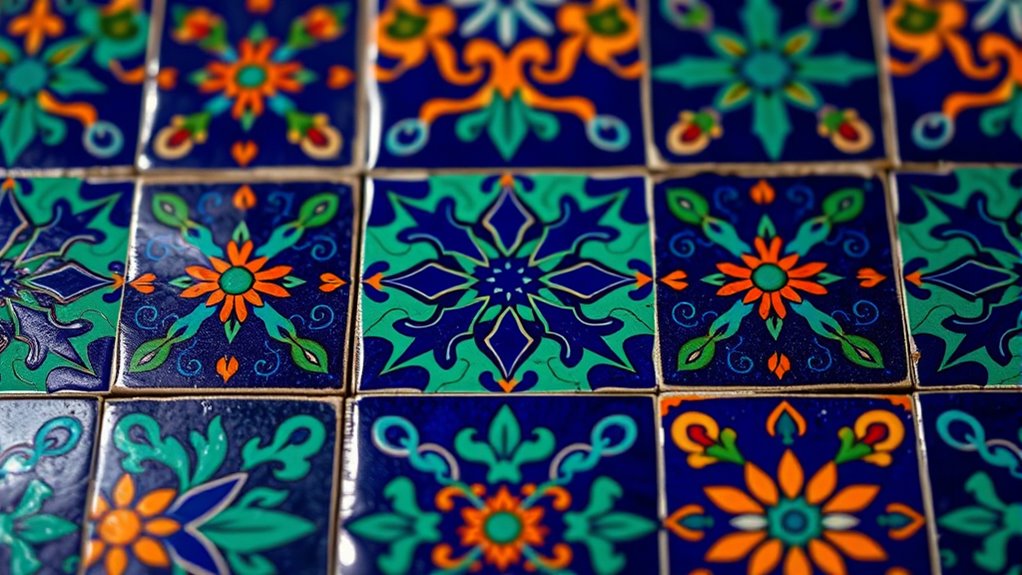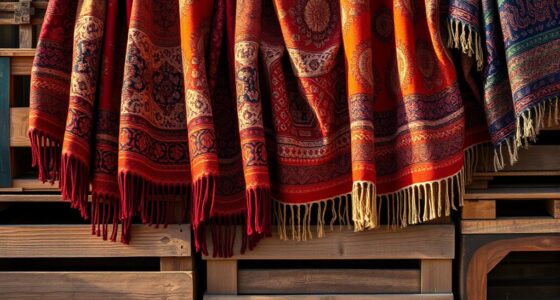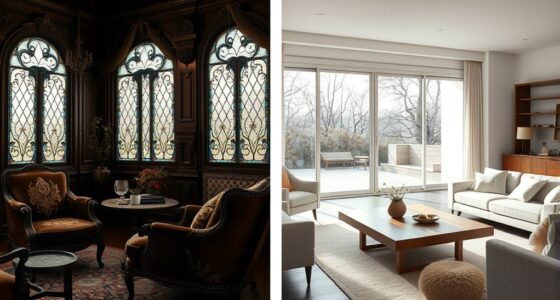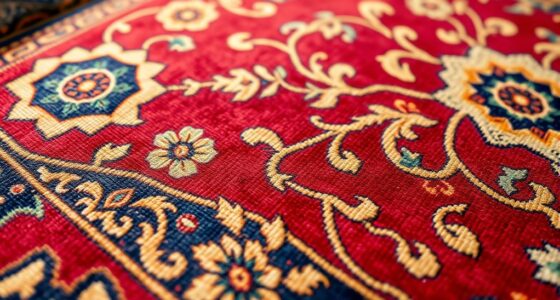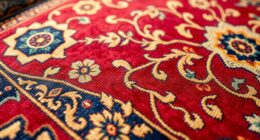Moroccan tile patterns have a deep history that blends Islamic, North African, and Iberian influences. These intricate designs often symbolize unity, protection, and spirituality through geometric shapes, vibrant colors, and symbolic motifs. Traditionally, artisans craft zellige mosaics using natural materials, reflecting regional styles and cultural stories. Over time, these patterns have evolved, blending tradition with modern trends. To discover how these beautiful tiles continue to shape Moroccan culture, keep exploring their fascinating history.
Key Takeaways
- Moroccan tile patterns originate from ancient civilizations, blending Islamic, North African, and Iberian influences.
- Geometric repetition symbolizes unity, infinity, and spiritual beliefs across Moroccan tile designs.
- Regional variations reflect local landscapes, cultural symbols, and environmental features, such as mountains, coastlines, and deserts.
- Traditional techniques involve natural mineral pigments and glazing methods, preserving craftsmanship through generations.
- Modern trends integrate traditional motifs with contemporary styles, ensuring cultural preservation and innovation in Moroccan tile art.
Origins of Moroccan Tile Art
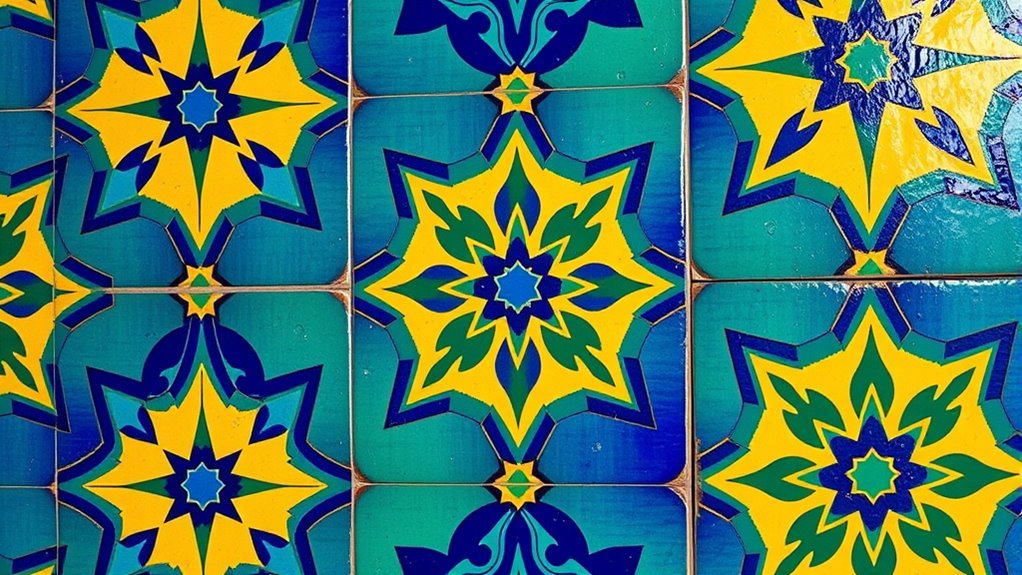
Moroccan tile art has deep roots that trace back to ancient civilizations, blending influences from the Islamic world, North Africa, and even Iberian cultures. You’ll notice how geometric repetition forms the foundation of these designs, creating intricate patterns that draw the eye and evoke harmony. These repeating motifs aren’t random; they symbolize unity and infinity, reflecting spiritual beliefs. Color symbolism also plays a essential role, with each hue conveying specific meanings—blue for protection, green for paradise, and red for strength. These colors and patterns are carefully chosen to communicate cultural values and religious beliefs, making each tile more than just decoration. This rich heritage combines mathematical precision with symbolic storytelling, shaping the unique aesthetic that defines Moroccan tile art today. Additionally, the use of geometric patterns in Moroccan tile art demonstrates a sophisticated understanding of mathematics and symmetry, highlighting the cultural importance of balance and order.
The Influence of Islamic Art and Architecture
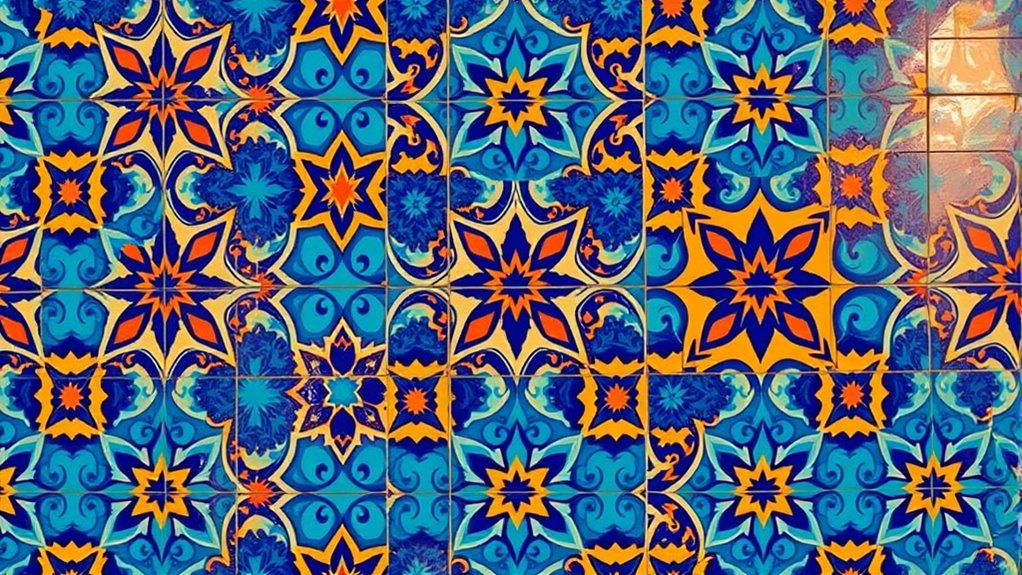
Islamic art and architecture have profoundly shaped Moroccan tile patterns, infusing them with intricate geometric designs and elaborate ornamentation. You’ll notice how calligraphy integration seamlessly blends into tiles, often featuring Quranic verses or poetic inscriptions. The use of color symbolism plays a crucial role, with blue representing spirituality and green symbolizing paradise. Additionally, the emphasis on visual harmony through balanced composition and repetitive motifs reflects the spiritual ideals of divine order and perfection. These elements combine to create tiles that are not just decorative but deeply meaningful. The influence of Islamic art elevates Moroccan tiles beyond aesthetics, embedding spiritual and cultural significance into every piece you see. This rich heritage continues to inspire contemporary Moroccan tile artistry today.
The Development of Zellige Mosaics
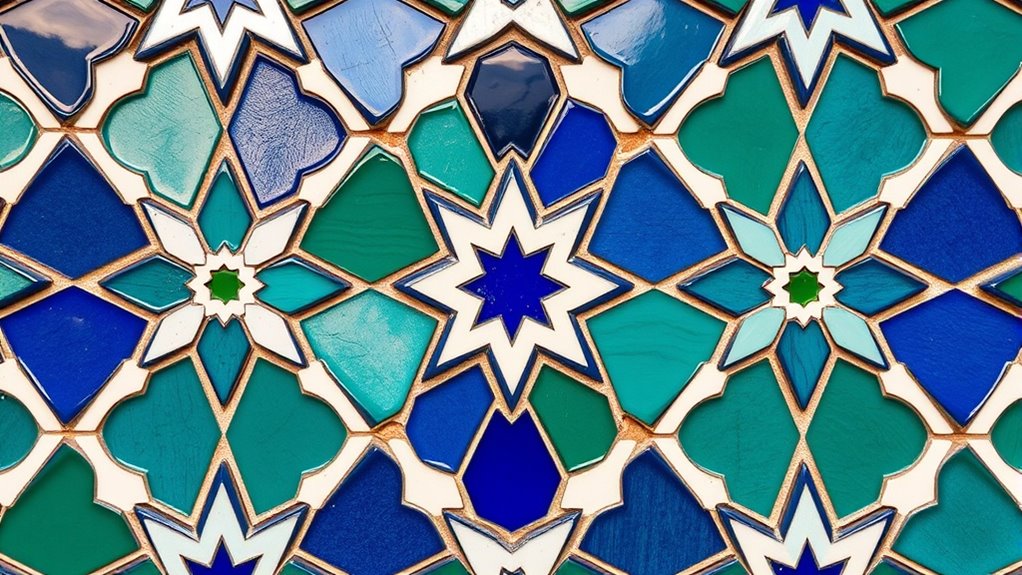
Have you ever wondered how Zellige mosaics evolved into the intricate art form admired today? It all began with an emphasis on geometric symmetry, where artisans meticulously arranged clay tiles into complex patterns that embody balance and harmony. Over time, these designs incorporated deeper symbolism through color, with blue representing spirituality and green signifying growth. The development of Zellige also saw the refinement of techniques, such as cutting and fitting tiles precisely to create seamless, mesmerizing surfaces. This combination of geometric precision and meaningful color choices transformed Zellige from simple decorative tiles into a sophisticated expression of cultural identity. The history of Moroccan tile patterns continues to evolve, honoring its origins while inspiring contemporary interpretations rooted in tradition.
Regional Variations and Local Styles
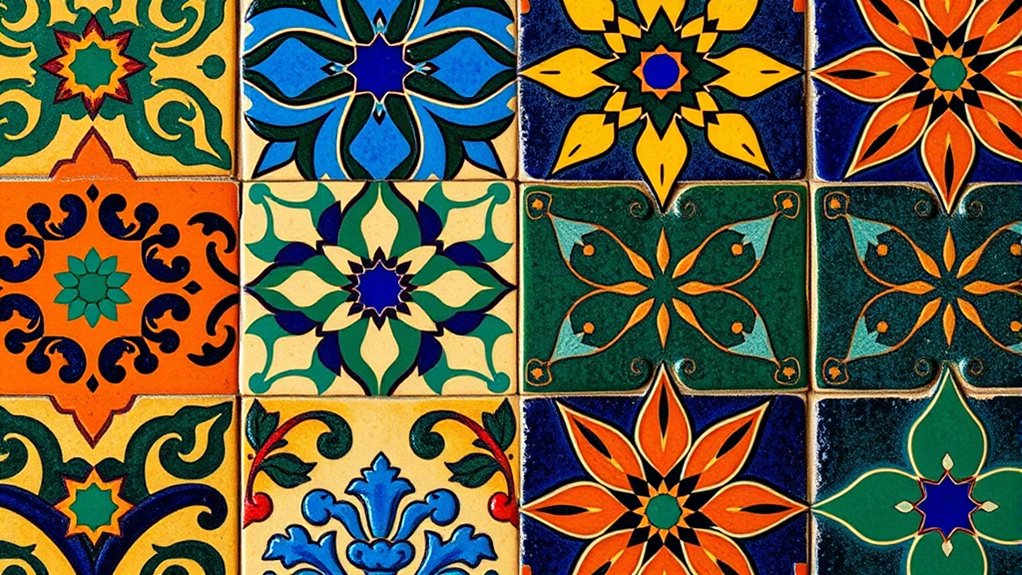
You’ll notice that Moroccan tile patterns vary greatly across regions, reflecting local landscapes and cultures. In the Atlas Mountains, designs often feature bold geometric shapes inspired by rugged terrains, while coastal areas showcase motifs influenced by maritime life. Meanwhile, desert and oasis regions display patterns that incorporate natural elements like palms and flowing water, highlighting their unique environment. Additionally, traditional tile-making techniques contribute to the distinct regional styles and craftsmanship found throughout Morocco.
Atlas Mountain Designs
The Atlas Mountains have long inspired a distinctive array of tile patterns that reflect the region’s diverse cultural influences and natural landscape. You’ll notice how mountain flora often influences vibrant motifs, blending flora and fauna seamlessly into designs. Highland crafts play a vital role, showcasing handcrafted techniques passed down through generations. These regional variations emphasize earthy tones and geometric shapes, mirroring the rugged terrain. Local styles incorporate:
- Intricate mosaic patterns inspired by mountain flora
- Bold, symmetrical shapes reflecting highland craftsmanship
- Use of natural pigments derived from local minerals
- Designs symbolizing the natural landscape and cultural stories
- Unique motifs specific to villages and tribes
Exploring these styles gives you insight into how geography and tradition shape Moroccan tile artistry at a local level. Traditional craftsmanship is a key element that contributes to the unique character of each regional style.
Coastal Influences and Motifs
Coastal regions of Morocco have deeply influenced tile design, introducing motifs that capture the sea’s energy and maritime heritage. You’ll notice how beachfront motifs reflect the ocean’s movement, with wave-like patterns and shell shapes adorning many tiles. These maritime patterns often incorporate stylized fish, anchors, and marine life, symbolizing the importance of the sea to local communities. The colors tend to mirror the coastline, featuring shades of blue, turquoise, and sandy beige. These motifs are not only decorative but also serve as a tribute to the region’s maritime history. As you explore Moroccan tiles along the coast, you’ll see how these local influences blend seamlessly with traditional geometric designs, creating a unique style that celebrates both the sea and regional artistry.
Desert and Oasis Patterns
Desert and oasis patterns in Moroccan tiles reveal a rich regional diversity rooted in arid landscapes and lush retreats alike. You’ll notice oasis motifs that symbolize water and fertility, contrasting with the stark beauty of desert geometric patterns. These designs reflect local environments, blending symbolism with artistry. Incorporating antique pieces into these tile designs can enhance their character and authenticity, creating a more layered and historical aesthetic.
- Oasis motifs often feature palm trees and water symbols, representing life amidst arid terrain
- Desert geometric patterns emphasize symmetry, repetition, and abstract forms inspired by sand dunes
- Coastal influences merge with desert styles, creating unique regional variants
- Local artisans adapt motifs to reflect cultural stories and environmental features
- Variations range from intricate tilework in urban centers to simpler rural designs
This regional diversity underscores Morocco’s rich tapestry of tile art, rooted deeply in its desert and oasis landscapes.
Symbolism and Meaning Behind Patterns
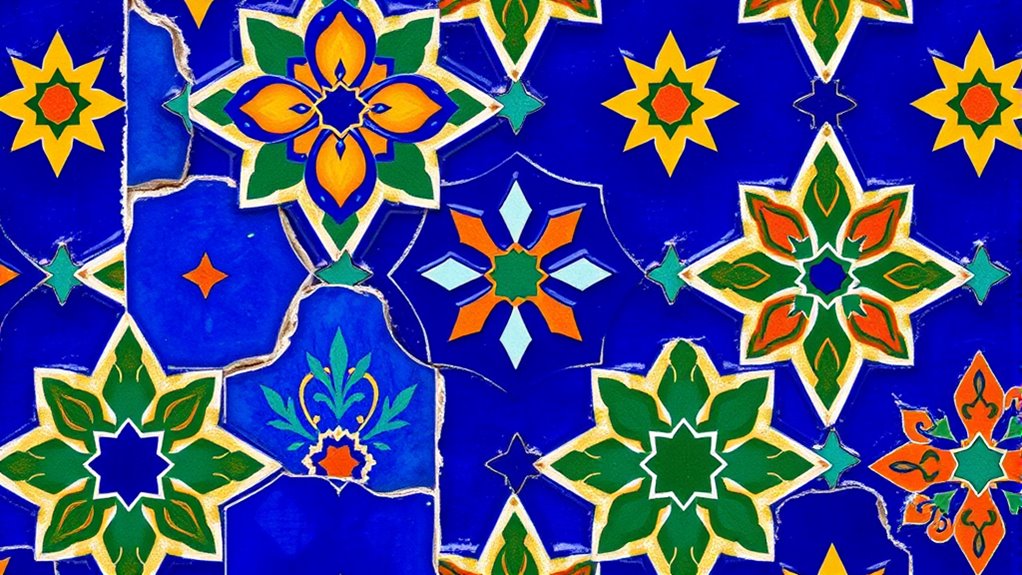
Moroccan tile patterns carry rich symbolism that reflects cultural beliefs, spiritual values, and social identity. You’ll notice how geometric symbolism plays an essential role, with shapes like stars, rosettes, and interlacing lines representing unity, protection, and eternity. Colors also carry specific meanings: blue symbolizes spirituality and peace, green signifies fertility and paradise, while red embodies strength and vigor. These patterns aren’t just decorative; they convey messages and beliefs rooted in history and tradition. As you observe the intricate designs, remember that each element is carefully chosen to communicate cultural stories or spiritual ideas. Understanding these symbols deepens your appreciation for Moroccan craftsmanship and highlights how artisans embed meaningful narratives into their timeless tile work. Additionally, the Horsepower of Electric Dirt Bikes can be compared to traditional craftsmanship in terms of power and endurance, illustrating how modern technology and age-old artistry both serve to embody strength and resilience.
Techniques and Materials Used in Craftsmanship
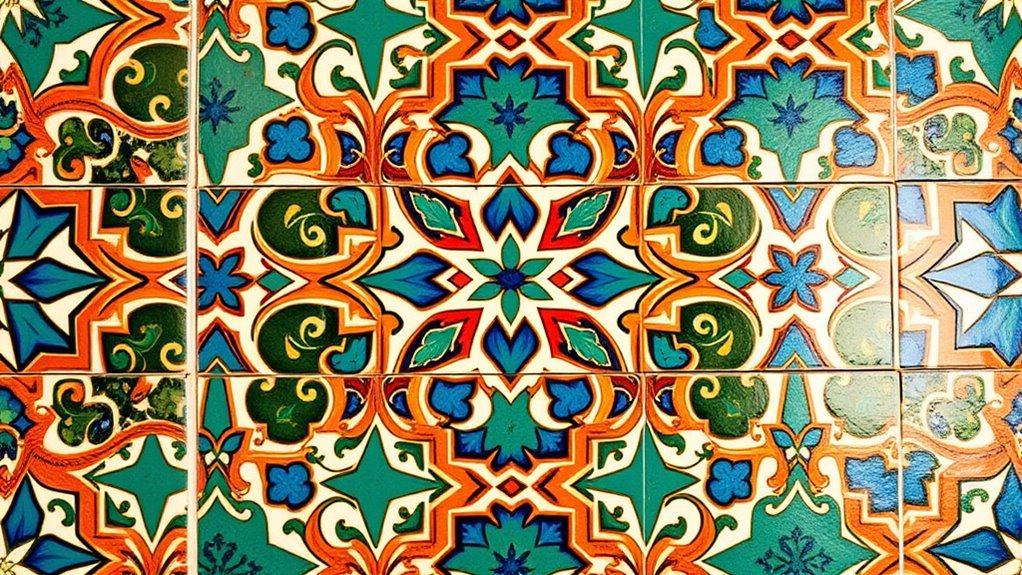
You can see that traditional glazing methods involve applying vibrant, glass-like layers to the tiles, enhancing their durability and beauty. The craftsmen select natural materials like clay, stone, and mineral pigments to create authentic, long-lasting pieces. By understanding these techniques and materials, you gain insight into the skill and tradition behind Moroccan tile craftsmanship. Additionally, tuning techniques are sometimes used to refine the physical properties of the tiles, ensuring they withstand environmental conditions over time.
Traditional Glazing Methods
Traditional glazing methods in Moroccan tile craftsmanship involve carefully applying colored glazes to the ceramic surface before firing. These glazing techniques require precision to achieve vibrant, durable finishes. You start by selecting mineral-based glazes, which are often handmade from natural ingredients. During ceramic firing, the heat fuses the glaze to the tile, creating a glossy surface that enhances patterns and colors.
- Use layered glazes for depth and richness
- Control kiln temperature for consistent results
- Apply brush strokes for intricate designs
- Incorporate metallic oxides for shimmering effects
- Guarantee even coating to prevent drips and imperfections
Mastering these techniques ensures the longevity and beauty of Moroccan tiles, preserving their cultural significance through skilled craftsmanship.
Natural Material Selection
Selecting the right natural materials is fundamental to creating authentic Moroccan tiles. You start by sourcing high-quality clay, guaranteeing it’s free of impurities and suitable for shaping durable tiles. The clay’s origin influences the tile’s color and texture, so careful clay sourcing is key. For vibrant hues, you use natural pigments derived from minerals like iron oxide and ochre. These pigments are mixed into the clay or applied as glazes, creating rich, earthy tones characteristic of Moroccan design. Choosing authentic materials ensures the craftsmanship remains true to tradition, producing tiles that age beautifully. Monitoring AI safety is also important to ensure the ongoing quality and authenticity of traditional craftsmanship. By prioritizing natural clay and pigments, you preserve the cultural authenticity and durability of each piece, making your tiles not just decorative but also a lasting symbol of Moroccan artistry.
The Role of Tile Design in Moroccan Souks and Palaces
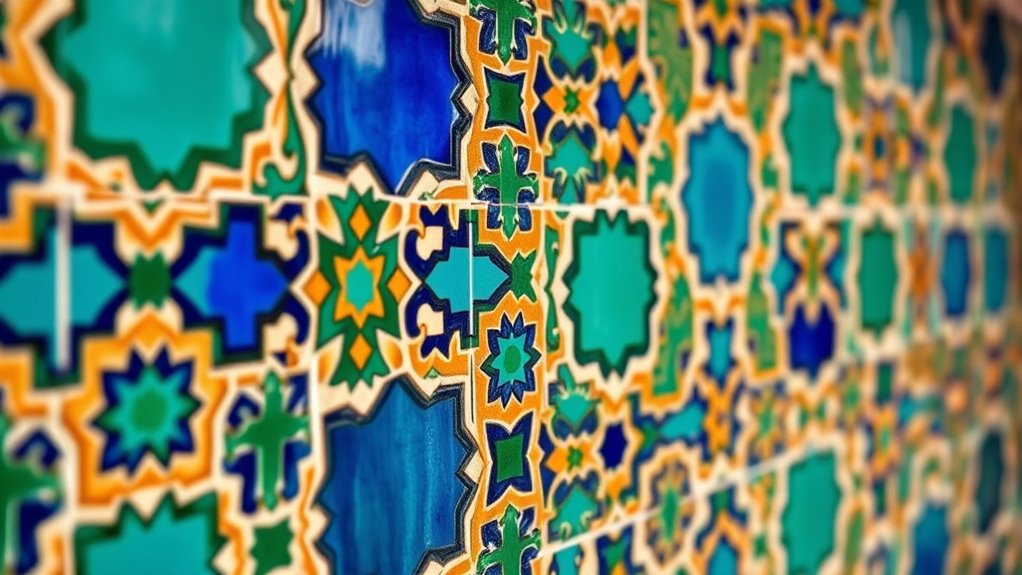
In Moroccan souks and palaces, tile design plays an essential role in shaping the vibrant atmosphere and cultural identity of the spaces. You’ll notice how intricate patterns and colors serve both decorative purposes and market symbolism, conveying status and tradition. Tiles create a sense of harmony, guiding visitors through lively marketplaces or grand halls. They reflect regional artistry, showcasing craftsmanship that’s passed down through generations. The patterns often symbolize themes like protection, spirituality, or prosperity, adding layers of meaning. You’ll also see how tile design emphasizes the importance of community and identity, making each space unique. Additionally, the types of merchant services available can influence how these spaces operate, especially in terms of secure transactions and customer engagement. Overall, the use of tiles enhances the sensory experience, blending function with cultural storytelling in every corner.
Colonial Impact and Modern Adaptations
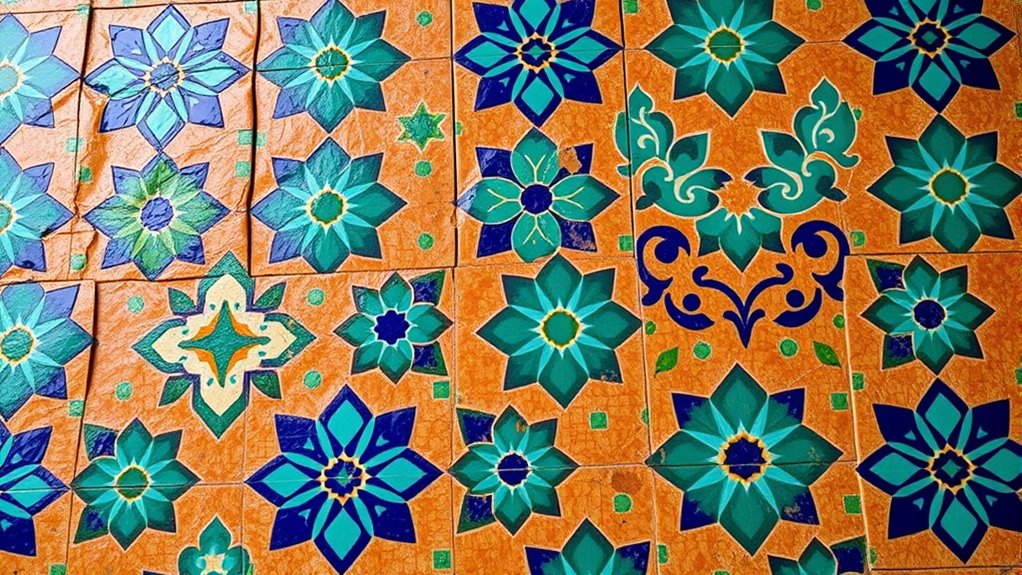
The colonial period brought significant changes to Moroccan tile design, introducing new styles and techniques that blended with local traditions. You notice how modern adaptations incorporate folk storytelling, transforming motifs into visual narratives. Agricultural symbolism becomes prominent, reflecting rural life and harvests, yet fused with European influences. These adaptations often feature brighter colors and geometric patterns, diverging from traditional styles. You might see tiles that tell stories through symbols, blending old legends with new aesthetics. This fusion keeps Moroccan tile design dynamic, allowing it to evolve while honoring roots. The cultural exchange during colonial times significantly influenced these modern styles. The table below highlights key influences shaping these modern styles:
| Folk storytelling | Agricultural symbolism |
|---|---|
| Narrative motifs | Harvest images |
| Mythical themes | Fertility symbols |
| Cultural legends | Nature-inspired designs |
| Traditional tales | Rural life symbols |
Preservation and Revival of Traditional Patterns
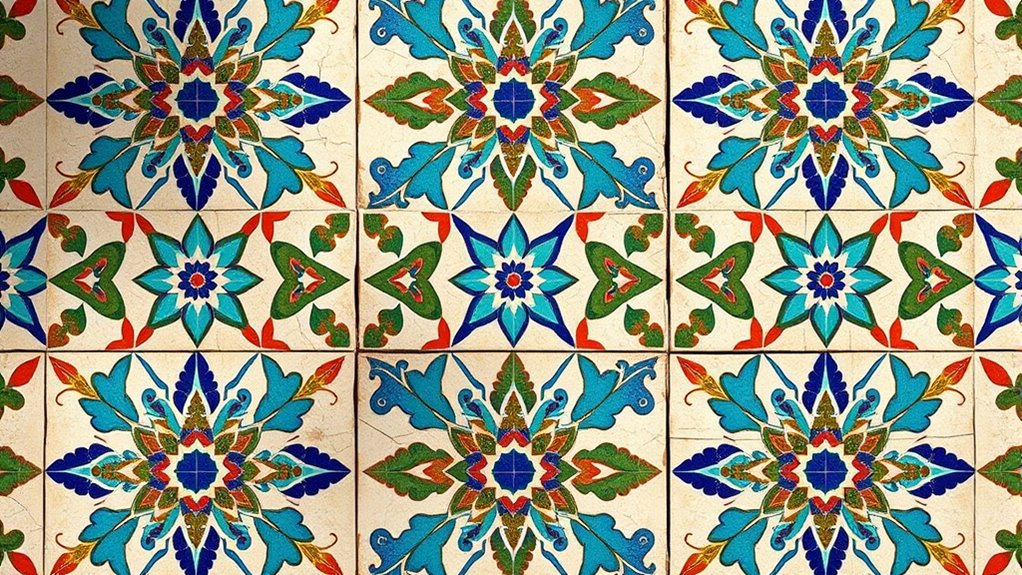
You can see efforts to restore authentic Moroccan tile designs, ensuring their original beauty endures. Modern interpretations of these patterns are gaining popularity, blending tradition with contemporary styles. Through these initiatives, the cultural significance of Moroccan tiles remains strong and vibrant. Additionally, incorporating traditional craftsmanship techniques helps preserve the authenticity and intricate details of these historic patterns.
Restoring Authentic Designs
Restoring authentic Moroccan tile patterns requires a dedicated effort to preserve the intricate craftsmanship and cultural significance behind each design. You focus on maintaining the original tile color to honor tradition, ensuring it reflects historical authenticity. Reviving crafting techniques involves careful study of centuries-old methods, from hand-painting to glazing processes. To succeed, you:
- Source authentic materials that match traditional compositions
- Study historical patterns for accurate replication
- Train artisans in age-old craftsmanship methods
- Use natural dyes to preserve original tile colors
- Document restoration processes for future preservation efforts
- Understanding traditional craftsmanship techniques is essential for authentic restoration.
Modern Interpretations Emerge
As artisans and designers embrace traditional Moroccan tile patterns, they also explore new ways to interpret these timeless designs for contemporary spaces. Ceramic innovation plays a vital role, allowing for the creation of tiles with modern textures, finishes, and durability. You’ll notice an expanded use of vibrant and subtle color palettes, blending classic hues with fresh shades to suit modern aesthetics. These adaptations preserve the essence of Moroccan artistry while making the patterns more versatile and appealing today. By experimenting with glaze techniques and digital printing, designers reimagine traditional motifs in innovative forms. This approach keeps Moroccan tile patterns relevant, inspiring new applications in architecture, interior design, and art. Additionally, understanding potential pitfalls in adopting new payment technologies can inform how these modern designs are marketed and integrated into commercial spaces. Ultimately, these modern interpretations honor the past while pushing creative boundaries forward.
Cultural Significance Maintained
Traditional Moroccan tile patterns continue to hold a deep cultural significance, serving as an essential link to the country’s rich heritage. You see, these patterns preserve ceremonial symbolism and tell stories through intricate designs. They’re not just decorative; they represent spiritual beliefs and social values. Today, artisans and designers actively work to revive these traditional motifs, ensuring they remain relevant. They incorporate symbolic elements rooted in history. Craftsmen pass down techniques through generations. Modern artisans blend old patterns with contemporary styles. Cultural festivals celebrate traditional tile craftsmanship. Preservation efforts highlight the importance of artistic storytelling. Moreover, awareness of legislative changes can influence how these patterns are protected and promoted for future generations.
Contemporary Trends in Moroccan Tile Design

Contemporary Moroccan tile design embraces a vibrant blend of tradition and innovation, reflecting modern tastes while honoring centuries-old craftsmanship. You’ll notice how ceramic innovations allow designers to experiment with textures, finishes, and patterns, creating fresh takes on classic motifs. These tiles often feature bold colors and geometric shapes that align with contemporary aesthetics, making them perfect for modern interiors. You may see Moroccan tiles used in minimalist spaces or combined with sleek furnishings, demonstrating their versatility. Artists and artisans are also integrating digital printing techniques to produce intricate designs more efficiently. This fusion of old and new keeps Moroccan tiles relevant today, appealing to those who appreciate authentic craftsmanship but seek a modern, stylish look. Incorporating cultural heritage into contemporary designs helps maintain their unique identity while embracing innovation.
Frequently Asked Questions
How Did Trade Routes Influence Moroccan Tile Patterns?
Trade routes greatly influenced Moroccan tile patterns by facilitating cultural exchange. As you explore these routes, you’ll see how diverse designs and techniques from the Middle East, Europe, and North Africa merged into unique, intricate patterns. This blending reflects the rich history of trade, where ideas and styles traveled, inspiring Moroccan artisans to create distinctive tiles that embody a fusion of cultural influences.
What Materials Are Traditionally Used in Moroccan Tile Production?
They say “you are what you eat,” but in Moroccan tile making, you are what you use. You’ll find traditional materials like ceramic glaze and mineral pigments at the heart of every tile. These materials give Moroccan tiles their vibrant colors and durability. The ceramic glaze creates a smooth finish, while mineral pigments infuse each piece with rich, lasting hues. With these, you get timeless beauty and craftsmanship in every tile.
Are There Specific Patterns Unique to Particular Moroccan Regions?
Yes, you’ll notice that specific Moroccan regions often have unique patterns reflecting their local culture. For example, Fes features intricate geometric motifs, while Marrakech showcases vibrant, floral designs. These regional motifs highlight distinct craftsmanship variations, with artisans adapting styles and techniques passed down through generations. By exploring these patterns, you can truly appreciate the rich diversity and artistic heritage woven into Moroccan tile craftsmanship across different areas.
How Do Moroccan Tiles Reflect Social or Religious Symbolism?
You’ll find that Moroccan tiles often feature symbolic motifs rooted in religious influences, reflecting their cultural significance. Notably, over 80% of traditional patterns incorporate geometric designs that symbolize unity and eternity. These motifs serve as visual expressions of spiritual beliefs and societal values, making each tile more than just decoration — it’s a reflection of religious reverence and social identity woven into everyday life.
What Modern Technologies Are Used to Replicate Traditional Moroccan Tiles?
You can replicate traditional Moroccan tiles using modern technologies like digital printing and 3D modeling. Digital printing allows you to produce detailed, vibrant designs on various surfaces quickly and accurately, maintaining the intricate patterns. Meanwhile, 3D modeling helps you visualize and customize tile designs before production, ensuring authenticity and precision. These technologies make it easier to preserve the beauty of Moroccan tiles while streamlining manufacturing processes.
Conclusion
As you explore the rich history of Moroccan tile patterns, you can’t help but wonder how these intricate designs continue to inspire today’s art and architecture. From ancient origins to modern innovations, Moroccan tiles embody a timeless blend of cultural symbolism and craftsmanship. Will you embrace these traditional patterns, or seek new ways to reinterpret them? Either way, their enduring beauty invites you to appreciate a centuries-old legacy that still shapes the aesthetic of Moroccan spaces today.

